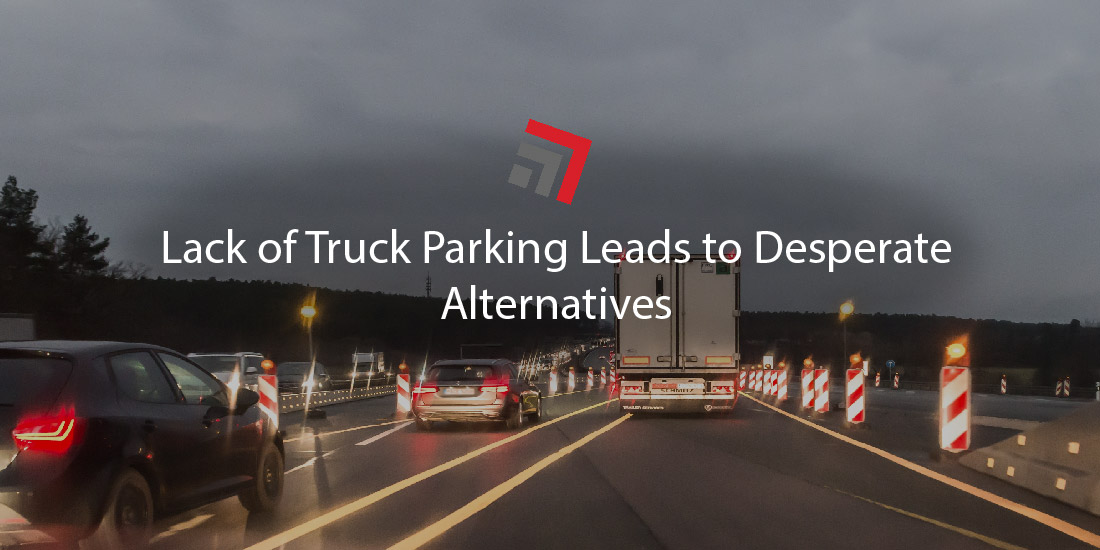Ask any professional truck driver this straightforward question: what’s your gravest concern that impacts day-to-day responsibilities as a driver?
Not knowing whether to cry or laugh, most drivers will utter a nationwide lack of parking available for their commercial trucks.
Finding a place to rest their rig is inherently an awkward predicament that every driver negotiates in some way or form.
Rigs are big. They weigh over 80,000 pounds, have a clearance of 13-feet, and, depending on the load, can extend well over 50-feet in length.
Moreover, especially for long-haul drivers, the journey of transporting a load is measured in days, maybe weeks, as opposed to hours. Overnight stops are necessary for the driver’s health and safety.
While robot trucks are vying to pull all-nighters someday, human drivers obviously need a place to pull over, park their truck, and rest their eyes.
That’s where parking availability, or lack thereof, comes into play.
Despite outspoken concern in the trucking community, the general public may not be aware of just how challenging it can be for drivers to safely (and legally) park overnight.
High demand plus little capacity equals illegal and unsafe parking alternatives
Per trucking interest groups and Transport Topics, there’s only one parking space for every 11 trucks on the road across the country.
This is bad news for truckers as they must comply with federal hours-of-service (HOS) rules which limit how long they can drive until the next day.
This unfathomable imbalance between demand for parking and available capacity leads to the old adage—desperate times, desperate measures.
With a lack of designated parking, truckers often resort to residential neighborhoods, highway shoulders, or interchange ramps.
Not only is this typically illegal, it’s also unsafe for the motoring public. This is an unavoidable consequence when there’s simply not enough designated parking spaces to go around.
“Truckers don’t want to park on the side of the road, but are forced to if designated parking areas are full and they run out of federally-regulated driving hours,” a spokesman for the Owner-Operator Independent Drivers Association (OOIDA) told Transport Topics.
Federal HOS rules permit truckers to drive for up to 11 hours during a 14-hour timeframe. Certain exceptions can be made in the event of severe weather or a major crash, but otherwise, these mandated rules must be followed like a farm dog herding sheep.
This 11-hour driving window also includes the time it takes for a driver to find a place to park overnight. Due to the parking crunch, many drivers shorten their workdays to ensure they have enough time to park. Of course, shorter workdays can lead to delayed deliveries.
With pressure to find a spot and not exceed hour limits, illegal and unsafe alternatives, like freeway shoulders or residential streets, all of the sudden become harbors for commercial vehicles.
Courtesy of the Pittsburgh Post-Gazette, Pennsylvania’s turnpike is one of many major roadways desperate drivers have flocked to.
Another place they will seek out are residential roads in towns and cities. This alternative has prompted the ire of local officials and residents.
Last fall, New York communities had a crackdown with overnight truck parking leading to many drivers having their rig towed, booted, or fined.
St. Paul, MN bans overnight truck parking
Close to the home of Commerce Express, St. Paul, Minnesota has been the most recent city condemning trucks parking on its roads.
Last month, Minnesota’s capital voted unanimously to ban parking for overweight and commercial vehicles when they’re not in active use.
St. Paul joins its twin city of Minneapolis in its decision to outright ban truck parking. The latter voted to do so in 2021 and has had a ban in effect since the start of 2022.
St. Paul’s new measure will go into effect January 1, 2024, and will forbid trucks from stopping, idling, or parking on any street or alley unless the driver is engaged in loading or unloading cargo from their vehicle.
In other words, if the driver is not carrying out any services, they have to keep it moving.
In the short term, the decision will likely relieve city neighborhoods and roadways from big rig hazards, but in the long term, this does nothing to solve truck parking capacity.
In fact, to the trucking community, it’s practically a slap in the face and a message: you’re on your own. Stakeholders have warned St. Paul that the parking ban will cause more delays with deliveries.
It goes without saying, but trucking groups and drivers alike are incensed with the city’s decision. We should expect to hear from Chris Spear soon.
Final Thoughts
However, the risk far exceeds the immediate hazard of big rigs jetting out on freeways and residential roads. Trucking interest groups warn a lack of designated parking contributes to driver fatigue and overall motoring safety.
While some action has been taken by regulators, stakeholders are perturbed by the remiss of federal, state, and local governments with the issue.
$1 billion was originally allocated for truck parking in 2021’s major infrastructure law, however the provision never made into the final version.
Contact one of our team members if you have any questions regarding this topic or any others in domestic logistics. In addition, stay current on rail and trucking developments with our weekly Road Map Newsletter.
More blogs similar to this:



Recent Comments